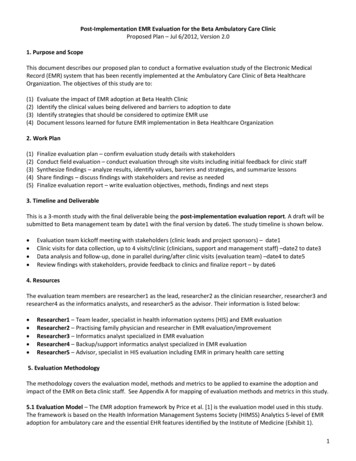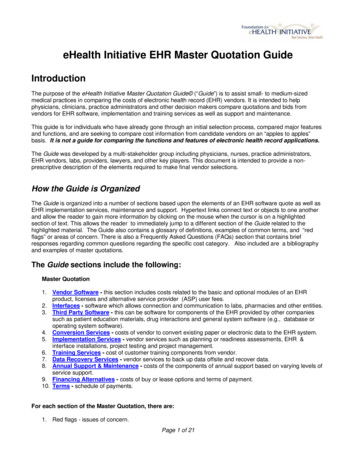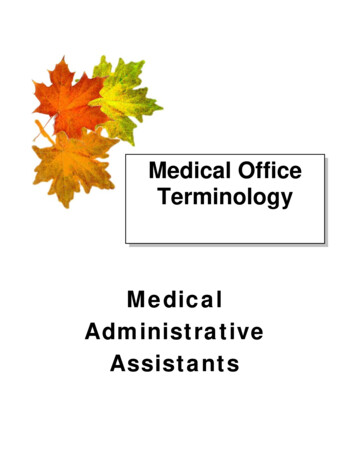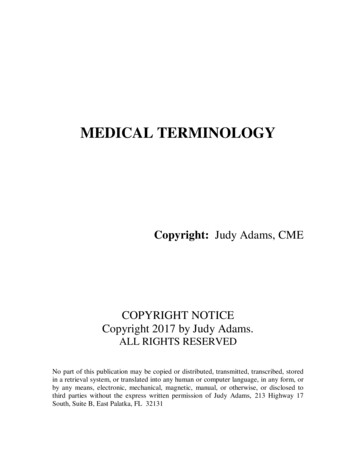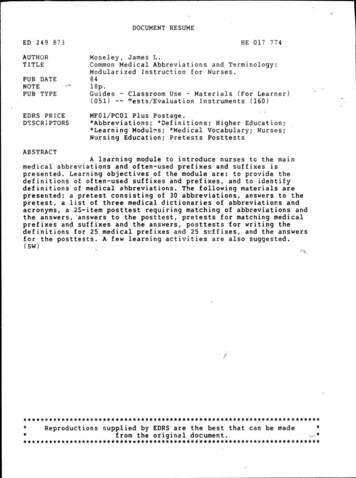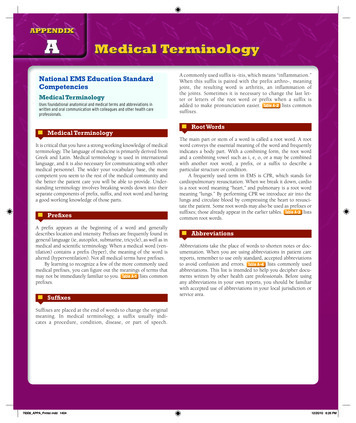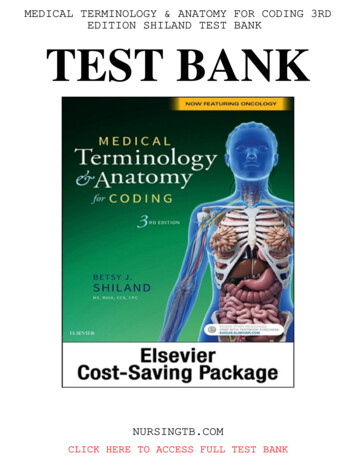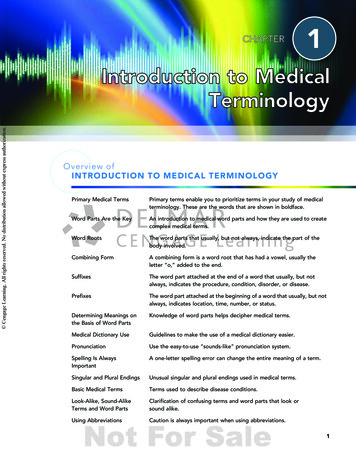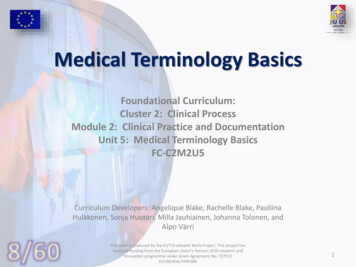
Transcription
Medical Terminology BasicsFoundational Curriculum:Cluster 2: Clinical ProcessModule 2: Clinical Practice and DocumentationUnit 5: Medical Terminology BasicsFC-C2M2U5Curriculum Developers: Angelique Blake, Rachelle Blake, PauliinaHulkkonen, Sonja Huotari, Milla Jauhiainen, Johanna Tolonen, andAlpo Vӓrri8/60This work is produced by the EU*US eHealth Work Project. This project hasreceived funding from the European Union’s Horizon 2020 research andinnovation programme under Grant Agreement No. 727552EUUSEHEALTHWORK1
Unit Objectives Discuss the four parts of medical termsRecognize word roots and combining formsIdentify medical prefixes and suffixesDefine common medical prefixesDefine common medical suffixesIdentify common medical root forms and combiningwords Identify some of the most common medical termsFC-C2M2U5This work is produced by the EU*US eHealth Work Project. This projecthas received funding from the European Union’s Horizon 2020research and innovation programme under Grant Agreement No.727552 EUUSEHEALTHWORK2
Medical Terminology Medical terminology is key to the clinicalprocess and clinical documentation Becoming familiar with medical terminology islike learning a new language Basic rules for building terms will help youboth build and translate many different words You must be able to put words together orbuild words from their parts– This is like putting together the pieces of a puzzleFC-C2M2U5This work is produced by the EU*US eHealth Work Project. This projecthas received funding from the European Union’s Horizon 2020research and innovation programme under Grant Agreement No.727552 EUUSEHEALTHWORK3
Understanding Medical Terms Medical terms are made of Latinand Greek word bases, and aresimilar in many languages; wewill cover the English equivalentin this curricula It is impossible to memorize allof the thousands of medicalterms However, you can figure out themeaning of many different wordssimply by analyzing the wordpartsFC-C2M2U5This work is produced by the EU*US eHealth Work Project. This projecthas received funding from the European Union’s Horizon 2020research and innovation programme under Grant Agreement No.727552 EUUSEHEALTHWORK4
Basic Word Parts Many common medical terms can be broken down intothe following components:– Root: A root is the base of the word, on which everything elseis built. To the root word, we can add an affix, or acomponent that modifies its meaning or creates a new word.The common medical terminology affixes include prefixes,suffixes and combining forms.– Prefix: A prefix is an element placed at the beginning of aword to adjust or qualify its meaning– Suffix: A suffix is an element placed at the end of a word toadjust or qualify its meaning– Combining form: A combining form is a form of a word thatoccurs only in combination with other forms. It is usuallyformed from one or more root words, or with a suffix.Combining forms contain combining vowels, such as “o” or “i”.FC-C2M2U5This work is produced by the EU*US eHealth Work Project. This projecthas received funding from the European Union’s Horizon 2020research and innovation programme under Grant Agreement No.727552 EUUSEHEALTHWORK5
Basic Word Parts (Cont’d)In the word periodontologistperi odont o logistprefixrootCombining vowelsuffixand there are three combining forms:“peri-”, “odonto-” and “-logist”FC-C2M2U5This work is produced by the EU*US eHealth Work Project. This projecthas received funding from the European Union’s Horizon 2020research and innovation programme under Grant Agreement No.727552 EUUSEHEALTHWORK6
Basic Word Parts (cont’d)Word PartExample (Meaning)Word Root cardia (the heart)Prefix tachycardia (condition of a fast heart rate)Suffix carditis (inflammation of the heart)Combining Forms cardio-myo-pathy heart muscle disease cardiomyopathy (disease of the heartmuscle)FC-C2M2U5This work is produced by the EU*US eHealth Work Project. This projecthas received funding from the European Union’s Horizon 2020research and innovation programme under Grant Agreement No.727552 EUUSEHEALTHWORK7
Word Roots Core or base part of the term Provides general meaning of the word Will frequently name a body partoste bonecardi heartrhino noseodonto teethFC-C2M2U5This work is produced by the EU*US eHealth Work Project. This projecthas received funding from the European Union’s Horizon 2020research and innovation programme under Grant Agreement No.727552 EUUSEHEALTHWORK8
Combining Words Combining roots and terms together in the form ofcombining words makes it possible to pronouncelong terms Combining terms use a vowel, usually an “o” (butcan also use other letters, such as an “i” Combining vowels combine two word parts:– Between two word roots– Between word root and suffixFC-C2M2U5This work is produced by the EU*US eHealth Work Project. This projecthas received funding from the European Union’s Horizon 2020research and innovation programme under Grant Agreement No.727552 EUUSEHEALTHWORK9
Combining Vowel Rules Just like in any language, there are rules regarding the use ofvowels. The rule here pertains to the use of the combining vowelbetween a word root and a suffix. If the suffix begins with a vowel, do not add a combining vowel. Forexample, in the word arthritis, “arthr” means joint and “-itis”means inflammation.– Typically, to combine the two we would use the combiningvowel “o”, but because the suffix “itis” begins with a vowel, wewould not use the “o”. We would just connect the two wordstogether to form the word “arthritis” If the suffix begins with a consonant, we would use the combiningvowel and we would typically use the combining vowel “o”.– For example, in the word arthroscope, “arthr” means joint, and“scope” means examine. Since the suffix begins with aconsonant, we would add the combining vowel “o” to connectthe two parts together to come up with “arthroscope”.FC-C2M2U5This work is produced by the EU*US eHealth Work Project. This projecthas received funding from the European Union’s Horizon 2020research and innovation programme under Grant Agreement No.727552 EUUSEHEALTHWORK10
Combining Vowel Rules (cont’d) Use combining vowels between the word root and suffix, unless the suffixbegins with a vowel– If the suffix begins with a vowel Do not use a combining vowel– arthritis (not arthroitis)– gastrectomy (not gastroectomy)– If the suffix begins with a consonant Use a combining vowel– arthroscope (not arthrscope) We typically will use the combining vowel between two root words, evenif the second word root begins with a vowel.– The combining vowel is typically kept between two word roots This is the case even if the second word root begins with a vowel– For example, “gastroenteritis” (not gastrenteritis)FC-C2M2U5This work is produced by the EU*US eHealth Work Project. This projecthas received funding from the European Union’s Horizon 2020research and innovation programme under Grant Agreement No.727552 EUUSEHEALTHWORK11
Combining Forms Typically, when we write word roots, we will includethe combining vowel. The format that is used is theword root followed by a slash and then the combiningvowel. These forms are typically used to create combinationmedical terms Combining forms also use the word root / combiningvowel format– Examples: FC-C2M2U5cardi/ohepat/ogastr/oend/oThis work is produced by the EU*US eHealth Work Project. This projecthas received funding from the European Union’s Horizon 2020research and innovation programme under Grant Agreement No.727552 EUUSEHEALTHWORK12
Examples of Combining Forms arthr/o – joint nephr/o – kidney cardi/o – heart neur/o- nerve dermat/o – skin ot/o- ear enter/o – small intestine pulmon/o – lung gastr/o – stomach rhin/o – nose hemat/o – blood ur/o – urine, urinarysystemFC-C2M2U5This work is produced by the EU*US eHealth Work Project. This projecthas received funding from the European Union’s Horizon 2020research and innovation programme under Grant Agreement No.727552 EUUSEHEALTHWORK13
Common Medical Combining Forms abdomin/o: abdomenaden/o: glandandr/o: malearteri/o: arteryarthr/o, articul/o: jointaudi/o: hearingbrachi/o: armbronch/i, bronch/o: bronchuscarcin/o: cancercardi/o: heartcarp/o: wristcephal/o: headcerebr/o, crani/o: brain, skullcervic/o: neck, cervixchem/o: chemical, drugcholecyst/o: gallbladdercol/o: coloncost/o, pleur/o: ribscyt/o: delldent/o, odont/o: teethderm/a, derm/o, dermat/o: skinencephal/o: brainFC-C2M2U5 enter/o: intestineerythr/o: redfaci/o: facegastr/o: stomachgynec/o: femalehemat/o, hem/o: bloodhepat/o: liverhist/o, histi/o: tissuehydr/o: waterhyster/o, uter/o: uteruslapar/o: abdomen, loin or flanklaryng/o: throat, voice boxleuk/o: whitelymph/o: lymph vesselsmamm/o: breastmening/o: membranous coveringsof the brain & spinal cordmy/o: musclenas/o-: nosenephr/o: kidneyneur/o: nerveocul/o: eye This work is produced by the EU*US eHealth Work Project. This projecthas received funding from the European Union’s Horizon 2020research and innovation programme under Grant Agreement No.727552 EUUSEHEALTHWORKonych/o, ungu/i, ungu/a: nailophthalm/o: eyeoptic/o, opt/o: seeing, sightorchi/o, orchid/o: testesor/o: mouthot/o: earpath/o: diseaseped/i, ped/o: foot or childpharmac/o: drugpharyng/o: throatpneum/o, pulmon/o: lungsrhin/o: nosesplen/o: spleensten/o: narrow, shortthorac/o: chest/thoraxthyr/o: thyroid glandtrache/o: neck or neckliketrich/o: hair or hairlikethromb/o: clotven/o: veinventr/i, ventr/o: front of bodyviscer/o: viscera (internal organs)14
Common Medical e(s)a-, an-not, withoutaphasia; anorexiahyper-extreme, beyond, above normalhypertensionab-away fromabductionhypo-under, below, less than normalhypoallergenicad-towardadductioninfra-below, underinfrarenalambi-bothambidextrousintra-on the inside, withinintrauterinebi-twobilateraliso-equal, sameisotonicbrady-fastbradycardiamal-bad, poormalabsorptiondys-bad, painful, difficultdyslexiamono-, uni-onemononucleosis; unilateralecto-, exo-outsideectoplasm; ri-surrounding, entriculareu-good, , beyondextraocularsuper-, supra-above, f, partFC-C2M2U5hemi-15
Common Medical e(s)-algiapainmyalgia-lysisdestruction, break entesispuncture a cavity to remove fluidamniocentesis-oma, -omatatumor, mass, fluid collection sease ofneuropathy-cytecelllymphocyte-pexysurgical fixationnephropexy-ectasia, -ectasissurgical dilitationbronchiectasis-plastysurgical repairrhinoplasty-ectomysurgical removal or oodanemia-rrhaphysurgical repair or sutureepisiorrhaphyinstrument used to record data;cardiograph,recordingcardiography-rrheaflow, dischargegalactorrhea-graph, -graphy-iasiscondition, formation, or presenceofcholelithiasis-scope, -scopyinstrument used for viewing; arthroscope,use of viewing sisstopping, standinghomeostasis-lepsis, -lepsyattack, seizurenarcolepsy-stomya new permanent openingtracheostomy-logystudy ofpsychology-tomycutting into, incisioncraniotomyFC-C2M2U516
75 Common Medical Terms You Should auscultationbronchitisadj.adj.n.n.n.n.n.8. chronic9. dermatitis10. ationdyspneaedemaembolismerythema16. eosinophil17. epistaxis18. febrilen.n.adj.19. fistula20. fracturen.n.21. gastroenteritis22. hematemesis23. hematoman.n.n.FC-C2M2U5severe, urgentwithout fevera condition of low red blood cell countchest paina respiratory condition with attacks of spasms in the bronchi of the lungsThe process of listening to sounds from the heart, lungs, or other organsinflammation of the mucous membrane in the bronchial tubesnon-severe, persisting for a long-time, ongoingInflammation of the skina disease where little or no insulin is produced or cannot be processed normally resulting in high levels of bloodsugarthe state of displacement or confusion whereas a person is unaware of time, place, position or identityshortness of breath, difficult or labored respirationan abnormal influx and excess accumulation of fluid in connective tissue or cavitythe sudden obstruction of a blood vesselabnormal redness of the skin or mucous membranes due to capillary congestiona component of white blood cell containing granules that are easily stained by a red fluorescent dye, eosin. It ispresent at sites of allergic reactions and parasitic infectionsmedical term for nosebleedmarked or caused by a feveran abnormal passage that leads from an abscess, organ, or body part to the body surface or another body part. Itmay be surgically created to permit passage of fluids.a rupture, tear or break in hard tissue, such as a bone, or soft tissue, such as a kidneyinflammation of the lining membrane of the stomach and the intestines characterized especially by nausea,vomiting, diarrhea, and crampsthe vomiting of blooda mass of usually clotted blood that forms in a tissue, organ, or body space as a result of a broken blood vesselThis work is produced by the EU*US eHealth Work Project. This projecthas received funding from the European Union’s Horizon 2020research and innovation programme under Grant Agreement No.727552 EUUSEHEALTHWORK17
75 Common Medical Terms You Should Learn (Cont’d)24. hyperglycemiahypertensionhyperventilationhypoglyc
Medical Terminology Medical terminology is key to the clinical process and clinical documentation Becoming familiar with medical terminology is like learning a new language Basic rules for building terms will help you both build and translate many different words You must be able to put words together or build words from their partsFile Size: 1MBPage Count: 26

